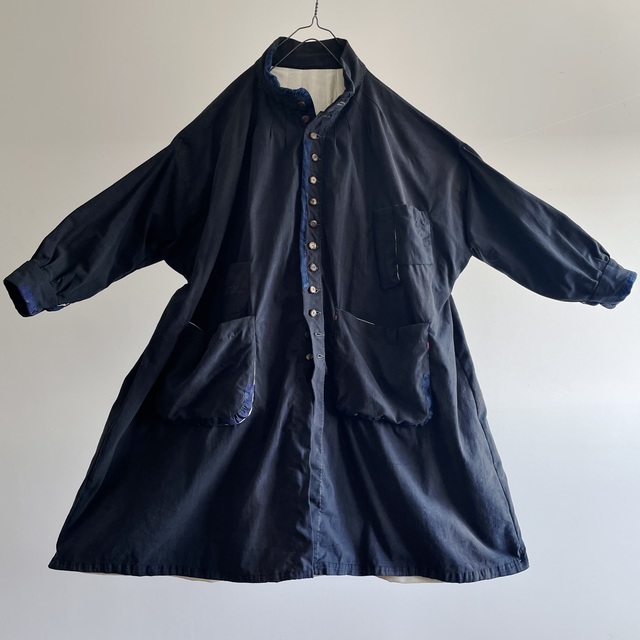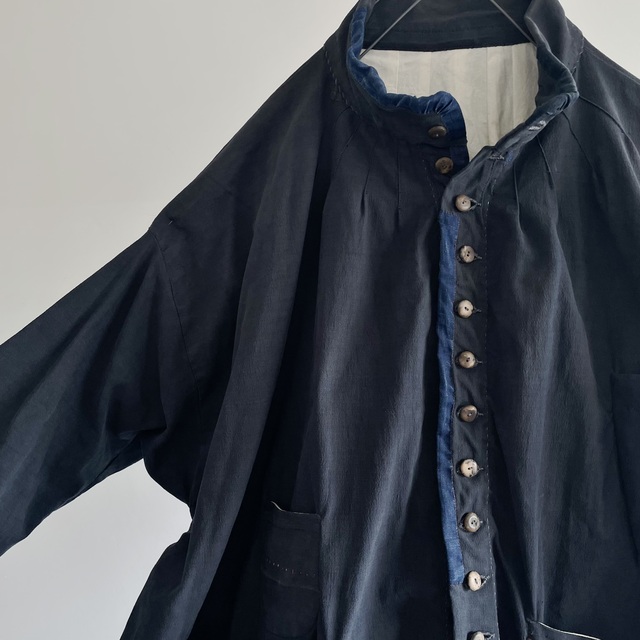SOLD
1940-1950 Vintage Toile de Coton Fabric Made French Chore Work Worker Maquignon Biaude Coat
1940年代にフランスで手作りされた、MaquignonのスモックをALTERATIONしたコート。ネック周りのプリーツに畳み込まれた通常の服の倍近いボリューム感のある身幅、広い肩幅、たっぷりした着丈など、着る人の全ての体格を包み込む圧倒的な迫力を持つ1枚です。
This coat is an ALTERATION of the Maquignon smock, handmade in France in the 1940s. It is a piece with overwhelming power that envelops all physiques of the wearer, with a body width that is almost twice the volume of normal clothing folded into pleats around the neck, wide shoulders, and ample length.


撚り杢のソルト&ペッパー生地のアトリエコートやフレンチサージやモールスキンのカバーオールやワークパンツ、太畝ピケのハンティングジャケットなど、独自のスタイルを見せながらも、現代に通用するモダンさを持ったスタイリッシュなワークウエアが勢ぞろいする中で、全く違った魅力を持つ仕事着がフランスにはあります。
While there is a wide range of stylish workwear with a unique style and modernity, such as atelier coats made of twisted salt and pepper fabric, coveralls and work pants made of French serge and moleskin, and hunting jackets made of thick-ribbed piqué, there is a completely different type of workwear with a completely different appeal in France.


一般的なフレンチワークは、都市部とその近郊地域での産業や商業の発展とともに発達し、制服的な意味合いで製造され、支給されたり、購入され着用されました。服飾知識と技術を持った専門家によるデザインとパターン製作や、縫製や工程の管理を基本とした、工業生産品のワークウェア自体が立派な商品であり、産業革命や近代化の結晶でした。
French work in general developed with the development of industry and commerce in urban and suburban areas, and was manufactured, supplied or purchased and worn in a uniform sense. Based on design and pattern making by experts with clothing knowledge and skills, as well as sewing and process control, industrially produced workwear was itself a respectable product and the fruit of the Industrial Revolution and modernization.



一方、周辺の農村部などでは、生活や仕事着が近代化されるのは1900年代の中期以降でした。今も食糧自給率が120%を超え、欧州連合(EU)一の農業生産国のフランスには牧畜に従事する人々が作り上げたBiaudeや、農家の室内着や寝間着になったスモックなど豊かな感性に彩られたフランス独自の様々な衣料や仕事着が自らの手で、手作りされていました。
In the surrounding rural areas, however, it was not until the mid-1900s that people began to modernize their lifestyles and work clothes. France, which is the largest agricultural producer in the European Union (EU) and still has a food self-sufficiency rate of over 120%, had a variety of handmade clothing and work clothes that were unique to France and colored with rich sensibilities, such as biaude made by cattle farmers and smocks used as indoor and sleeping wear by farmers.



フランスで1940年代に作られたBiaudeです。19世紀から20世紀中期ぐらいまでに着られていた、中世以降の農夫の作業着だったチュニックやスモックが原型となったもので、馬や牛の放牧などの牧畜者、羊飼いなども着たと言われていますが、中でもMaquignonという名で呼ばれる馬の仲買人が着ていたことがよく知られています。
This is a biaude made in France in the 1940s, and is the prototype of the tunics and smocks worn from the 19th to the mid-20th century, which were the working clothes of farmers from the Middle Ages onward.
It is said to have been worn by herdsmen and shepherds who herded horses and cattle, but it is most well known that it was worn by horse brokers, known as maquignon.



Maquignonは元々オランダ語のmakelare(仲介や交渉)から派生した名称で、当初は馬のディーラーを指していましたが、やがて馬主や飼育業者までを指す言葉となっていったようです。
Maquignon was originally derived from the Dutch word makelare (intermediary or negotiation), and initially referred to horse dealers, but eventually became a term for horse owners and breeders as well.


この写真は1850年あたりの、牛や羊など家畜業者が集まるパリのLa Villetteの家畜・食肉市場の写真には、BiaudeやVilletteと呼び名のついたワークコート(後のアトリエコート)を着た人々の姿が映っています。Biaudeを着て、牛や馬を引いて続々とパリの街中の市場へ集まってくるMaquignonや家畜業者の姿は、きっと普通の市民にとっては印象深い光景だったのだろうと思われます。
This photo of the La Villette livestock and meat market in Paris around 1850, where cattle, sheep, and other livestock dealers gathered, shows people wearing work coats (later atelier coats) called biaude or villette. wearing biaude, pulling cattle and horses one after another. The sight of maquignons and livestock dealers gathering at the markets in the streets of Paris must have been an impressive sight for ordinary citizens.



フランスの馬の飼育ではノルマンディーが有名ですが、フランスにはもう一つAuvergne(オーベルニュ)地方というフランスの中央山塊の農業条件不利地域があり、この地域のカンタル県でも馬飼育の長い歴史があります。耕作に適さない山地のオーベルニュでは、牛飼養農家が全体の約70%を占め、残りを羊飼養と馬飼養、耕種農業が構成しています。
Normandy is famous for horse breeding in France, but there is another region in France called Auvergne, an agriculturally disadvantaged area in the central massif of France, and the Cantal department in this region also has a long history of horse breeding. In Auvergne, a mountainous region unsuitable for arable farming, cattle farms account for about 70% of the farms, with sheep farming, horse farming, and arable farming making up the remainder.


このAuvergne地域の家畜農家が昔から着ていて、仕事着にも正装着にもしていたインディゴで染められたリネンのスモックが、馬の取引に来たMaquignonに伝わってBiaudeとして広がっていたのではないかという説があります。この写真は正装をして「Auvergneのブーレ」という曲を踊る19世紀の村人の姿です。
There is a theory that the indigo-dyed linen smocks worn by livestock farmers in this Auvergne area for centuries, and used as both work clothes and formal wear, may have been introduced to Maquignon, who came to trade horses, and spread as Biaude. This photo shows 19th century villagers in formal wear dancing to the tune “Boule de Auvergne”.



Auvergneにはもう一つ、パリのカフェ文化を作り出したという側面があります。耕作が出来ず貧しかったAuvergneの人々が出稼ぎに出て、水道のなかった頃には水を担いで売り歩き、水道が普及すると炭を売り、炭を売るための保管場所の部屋を借り、その部屋の片隅で酒や飲み物を売り始めたのが、フランスのカフェの始まりという話があります。
Another aspect of Auvergne is that it created the café culture of Paris. The story goes that the people of Auvergne, who were poor and unable to cultivate land, went out to work and sold water when there was no running water, and when running water became widespread, they sold charcoal, rented a room to store charcoal for sale, and began selling alcohol and drinks in a corner of the room, which was the beginning of the French café.


実際に30年ほど前まではカフェの80%ぐらいがAuvergne出身者で占められていて、フランスが世界に誇るカフェ文化を作り上げているのが、パリの洗練とは対極の位置にある田舎の出身者だというのは不思議な対比です。朝早くから夜遅くまで休みなく飲み物も酒も食べ物も提供するカフェは、忙しくきつい商売なので後継者が不足して、現代でもそういったきつい仕事を厭わない中国人が権利を引き継ぎ、Auvergne人にとり変わろうとしているのは、寂しい時代の趨勢です。
In fact, until about 30 years ago, about 80% of the cafes in France were run by people from Auvergne. It is a strange contrast that the people who have created France’s world-class café culture are from the countryside, the opposite of Paris’ sophistication.
Cafes, which serve drinks, alcohol, and food from early in the morning until late at night without a break, are a busy and demanding business, and there is a shortage of successors. It is a sad trend of the times that even today, Chinese who are willing to do such hard work are taking over the rights and replacing them with Auvergne people.



生地はToile de coton(トワル)と呼ばれる、フランスの打ち込みの緩やかな綿帆布。時を経た生地の変化と、深みのあるブルーグレーの落ち着いた色合い。
The fabric is Toile de coton, a French cotton canvas with a gentle weaving. The fabric has changed over time and has a deep, subdued blue-gray hue.



注文したオーナーが大きな体格の持ち主だったのか、この分量がこの1枚を作った作り手の標準だったのかは分かりませんが、1mを超える身幅の圧倒的なボリュームと迫力が魅力溢れる1着です。
We do not know if the owner who ordered it had a large physique or if this quantity was the standard for the maker who made this piece, but the overwhelming volume and power of this piece, with a body width of over 1 meter, is full of charm.


ネックの周りや袖にとったプリーツの作り出す控えめな柔らかさ。袖と身頃の圧倒的なボリュームをまとめ、着る人の体格を選ばず、その人それぞれのシルエットを作り出す魔法の1枚。
The discreet softness created by the pleats around the neck and sleeves. The overwhelming volume of the sleeves and body is combined to create a magical piece that creates a silhouette for each individual, regardless of the wearer’s physique.



簡単な形の襟や襟の無い形がほとんどのこの頃のBiaudeでは珍しいしっかりとした分量のスタンドカラーの襟。リネン以外の生地で作った素材選び、襟の形、迫力のある分量感、ギャザーではなくプリーツにした仕様。この頃の標準的な型から一歩踏み出した遊び心の見える1着です。
The collar is a stand collar with a solid volume, which is rare in Biaude at this time, when most of the collars are simple or collarless. The choice of material made from fabrics other than linen, the shape of the collar, the powerful volume, and the specification of pleats instead of gathers. It is a dress that shows a playful spirit, stepping out from the standard type of these days.



ダメージを補修して飾るPatch、ダーニングのハンドステッチを、一針ずつ丹念に、様々な方法で彩りました。色むら、擦り切れ、破れ、陽灼け、退色の痕。偶然と時間と人の手が紡ぎ出す、紙の上やデジタル画面の中からは、決して生み出されることのないものです。
Patch and darning hand stitching to repair and decorate the damage, each stitch painstakingly and in a variety of ways. Uneven colors, fraying, tears, sunburns, and fading marks. These are things spun by chance, time, and the human hand, and can never be produced on paper or on a digital screen.


長い時を経た、この存在自体がユニークなスモックを羽織れるようなコートにALTERATIONした1着です。プルオーバーのスモックタイプだったものを前開きに変更し、ボタンホールを作りボタンを付けました。
This is one piece that ALTERATION was made into a coat that can be woven from this smock that has been around for a long time and is unique in its own right. What was a pullover smock type was changed to a front opening, and button holes were made and buttons were attached.



選んだボタンは時間の痕跡が刻まれたフランスヴィンテージのcorozo(主にエクアドルのタグワ椰子)。時間を経過した事によるくすんだ光沢や不揃いな色合い、細かなヒビ割れなど、様々な変化が味わいを加えてくれます。
The buttons we chose are vintage French corozo (mainly tagua palms from Ecuador), which have traces of time etched into them. Various changes, such as dull luster, uneven coloring, and fine cracks, caused by the passage of time, add flavor to the piece.


vegetable ivoryの呼び名通りの乳白色の実を削って加工される何とも言えない丸みと、乳白色のベースを染める事で生まれる優しい色合いの魅力。見た目に反してしっかりした質感と重みを兼ね備えた、味わい深さを持ったボタンです。
As the name “vegetable ivory” implies, this button has an indescribable roundness created by shaving milky white berries, and the charm of the gentle coloring produced by dyeing the milky white base. Contrary to its appearance, this button has a solid texture and weight, and has a deep sense of taste.



ずらりと並ぶボタンホールも全てリネンコードの手縫いです。プラケットのハンドステッチと同じように、ミシンのホールには作り出せない意図せぬ乱れが味わいのある表情。
The buttonholes lined up in a row are also all hand-stitched with linen cords. Like the hand stitching on the placket, the unintentional disorder that cannot be created by the holes of a sewing machine gives a tasteful expression.



インパクトたっぷりの存在感の大きなポケット。ダメージを補修し、裏にrustic cottonをつけてさらに立体的に。
Large pockets with a large impact and presence. Damage has been repaired and rustic cotton has been added to the back to make it even more voluminous.


胸にはMaquignon特有の大きさの異なる二連ポケット。
Maquignon’s unique dual pockets of different sizes.



ダメージのあったスクウェア型のカフスを、ダメージの補修とともに折り返しもポイントになる丸みのある形に作り直し、仕事着のものとはまた違ったソフトな印象ものにしました。
The damaged square-shaped cuffs were repaired, and the folded over cuffs were reworked into a rounded shape that also serves as a point of reference. We gave them a softer impression different from the ones for work wear.



ライニングもすべて手によるブラインドステッチです。ミシンで縫えば数分の仕事に、その十倍以上の時間をかける事の意味はここにも宿ります。
All linings are also blind-stitched by hand. The meaning of spending more than ten times as much time on a job that would take only a few minutes if sewn with a sewing machine is also reflected here.



ヘムを軽くするために、止めつけずに浮かせてつけたライニングの裾。適度なボリュームを持たせるために深い見返しをつけ、ハンドステッチでアクセントを添えています。
To lighten the hem, the lining hem is floated instead of sewn. A deep turnover is added to give the right amount of volume, and hand-stitched accents are added.



衣服は骨董的な価値を求めるものではありません。その時、その時代を積み重ねて今に繋がる輝きに、現代性を融合させた
「古くて新しく、新しいけど古い」1点だけの存在。
Clothing is not about antique value. We are looking for a fusion of modernity with the brilliance of the past and the present.
It is a one-of-a-kind existence that is “old and new, new and old.


サイズ △(フリー)
肩幅 =70cm
バスト=95cm(脇下)
袖丈 =47 cm
着丈 =113cm
フランス/日本製
Front Fabric = Vintage Toile de Coton / Cotton 100%
Back Fabric = Indian Rustic Cotton Broad Cloth / Cotton 100%
Buttons = 1930-1940 Vintage French Corozo Button (Random Choice)
& Antique Fabric Covered Button
STOREへのリンク
1940-1950 Vintage Toile de Coton Fabric Made French Chore Work Worker Maquignon Biaude Coat
[ALTERATION By Manure of Drawers] SOLD

